Ikebana, the ancient Japanese art of flower arranging, captivates with its minimalist elegance. Unlike Western floral design, it prioritizes balance, asymmetry, and the inherent beauty of each stem and bloom. Through the Nageire and Moribana styles, practitioners cultivate a meditative practice that celebrates nature’s transiency. Rooted in Zen Buddhism, Ikebana offers a transformative experience – one that unveils the profound artistry and philosophy behind the delicate arrangement of flowers.
Good To Know
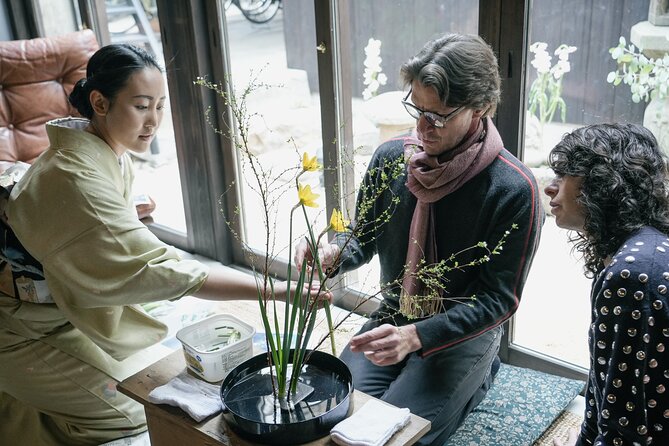
- Ikebana is the traditional Japanese art of flower arranging, emphasizing asymmetry, negative space, and harmony between flowers, container, and surrounding environment.
- The Nageire and Moribana styles, focused on in the experience, teach fundamental Ikebana principles like line, rhythm, and minimalism through hands-on practice.
- The class is led by an English and Japanese fluent guide, providing instruction and historical/philosophical insights on the deep roots of Ikebana in Zen Buddhism.
- The experience is hosted by Kaeribana, accommodating a maximum of 6 travelers, with a class price starting at $60.11 per person in Kamigyo Ward, Kyoto.
- Timely arrival is essential due to the class size limitation, and the venue is not wheelchair accessible.
Overview of the Ikebana Experience
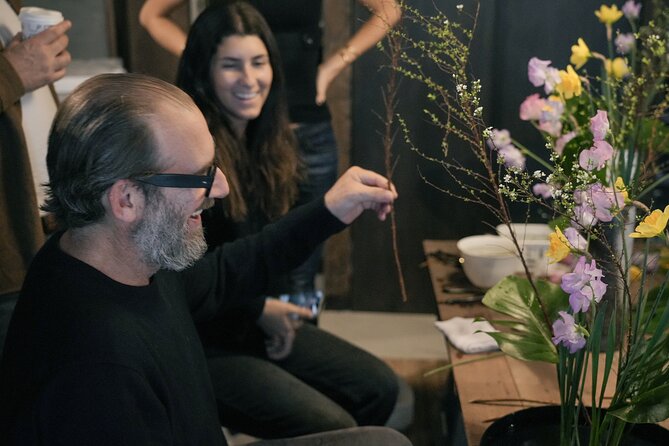
Ikebana, the traditional Japanese art of flower arranging, offers visitors a unique cultural experience in Kyoto.
Operated by Kaeribana, the classes accommodate a maximum of 6 travelers and are priced from $60.11 per person. The experience takes place at a meeting point in Kamigyo Ward, near public transportation.
Participants receive flowers and tools, with an English-and-Japanese-fluent guide leading the hands-on lessons. The focus is on two Ikebana styles – Nageire and Moribana – with an overview of the art’s history and philosophy.
Reviews praise the instructor’s guidance, environment, and flower quality, though some suggest more historical context and advanced rules in future classes.
Find more activities and experiences we've covered in Kyoto.
Meeting and Pickup Information
The meeting point for the Ikebana experience is located at 348-1 Tanbayachō, Kamigyo Ward, Kyoto, 602-8287.
While this location is subject to change, travelers can refer to the host’s message for any updates.
The activity ends back at the original meeting point.
The venue is near public transportation, but it’s not wheelchair accessible.
Participants should arrive on time, as the class is limited to a maximum of 6 travelers.
Refer to the provided confirmation for any changes to the meeting details.
Inclusions in the Ikebana Class
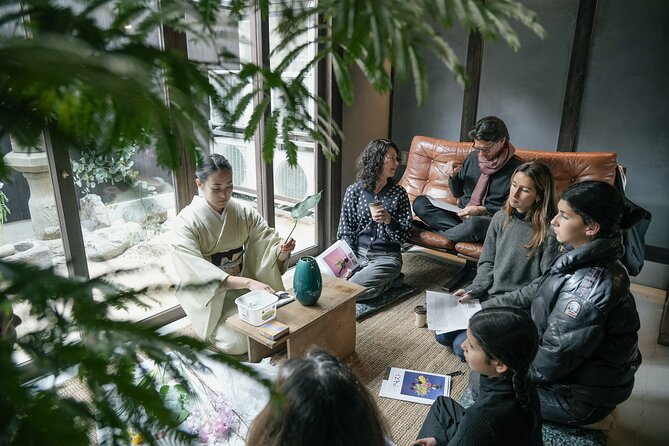
The Ikebana class includes several key elements to provide participants with a comprehensive learning experience.
Attendees receive all necessary flowers and tools for the hands-on flower arranging. An English and Japanese fluent guide leads the class, offering expert instruction and insights. Confirming the booking in advance ensures attendance.
The focus is on two Ikebana styles – Nageire and Moribana – with a blend of historical overview and practical techniques tailored for beginners.
While advanced training covers extensive rules, this class emphasizes the foundational principles and techniques to introduce students to the art of Ikebana.
Focus on Nageire and Moribana Styles
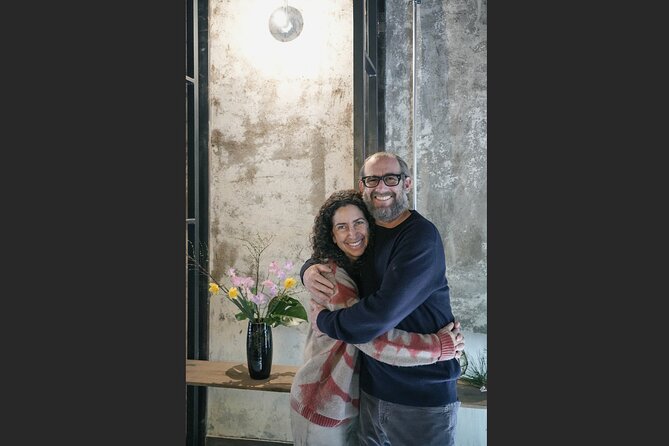
The class focuses on two primary Ikebana styles – Nageire and Moribana. Nageire is a more informal, freestyle approach emphasizing natural asymmetry. Moribana utilizes low, shallow containers to create a layered, balanced composition. Both styles teach fundamental Ikebana principles like line, rhythm, and minimalism.
| Nageire | Moribana |
|---|---|
| Informal, freestyle | Structured, layered |
| Asymmetrical lines | Balanced composition |
| Tall, narrow vases | Shallow, wide containers |
| Natural, wilder look | Carefully curated aesthetic |
The class provides hands-on experience with these styles, giving beginners a solid foundation in Ikebana’s core philosophies and techniques.
Emphasis on Hands-on Learning and Practical Tips

Hands-on learning and practical tips take center stage throughout the Ikebana class. Students get the chance to fully enjoy the art, crafting their own Nageire and Moribana arrangements.
The instructor provides guidance every step of the way, sharing key terminology and demonstrating essential techniques. Participants learn how to select and position the flowers, create depth and balance, and infuse each creation with personal expression.
Beyond the mechanics, the class also delves into the philosophical significance of Ikebana, revealing its deep roots in Japanese culture. This holistic approach ensures students leave with a well-rounded understanding of this revered art form.
- Full Coverage Kyoto Private City Tour
- Kyoto Casual Evening Pontocho Food Tour
- Kyoto Fushimi Hidden Route Hiking & Soba Lunch
- Kyoto Night Walk Tour (Gion District)
- Gion and Fushimi Inari Shrine Kyoto Highlights With Government-Licensed Guide
- Arashiyama Bamboo Grove Day Trip From Kyoto With a Local: Private & Personalized
Historical and Philosophical Significance of Ikebana
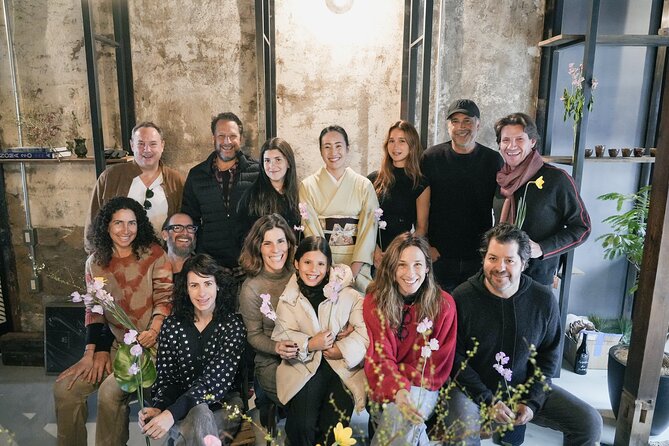
Ikebana’s rich history and philosophical underpinnings are woven throughout the art form. The principles of Ikebana are deeply rooted in Zen Buddhism, emphasizing harmony, simplicity, and a reverence for nature.
Key elements include:
Asymmetry: Compositions are intentionally asymmetrical, representing the natural imbalance found in the natural world.
Negative Space: Empty space is as important as the flowers themselves, symbolizing the concept of "ma" or the void.
Seasonality: Flowers are chosen based on the current season, reflecting the transient nature of life.
Mindfulness: The practice encourages a meditative state, where the arranger fully immerses themselves in the creative process.
Level of Instruction and Teaching Approach
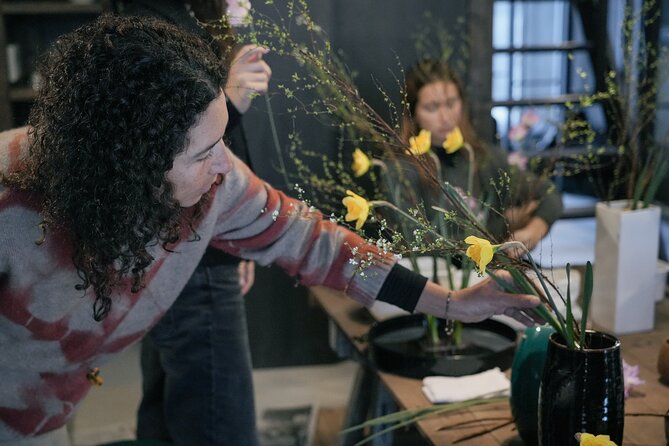
The Ikebana class at Kaeribana is designed with beginners in mind, focusing on a hands-on approach to teaching the fundamental techniques and philosophies of this centuries-old art form.
Under the guidance of an English and Japanese-speaking instructor, students will explore two primary Ikebana styles: Nageire and Moribana.
The class emphasizes practical application, with students creating their own floral arrangements using the provided materials.
While the course offers a brief overview of Ikebana’s historical significance and key terminology, the focus remains on equipping beginners with the essential skills and understanding to appreciate this delicate art.
Traveler Reviews and Feedback

Fourteen travelers have reviewed the Ikebana experience at Kaeribana, awarding it an average rating of 4.6 out of 5 stars.
The positive remarks highlight the instructor’s guidance, the serene environment, and the high-quality flowers. However, some participants suggested incorporating more historical context and advanced Ikebana rules into future classes.
Unfortunately, one traveler reported a disappointing experience, citing a no-show at the meeting point and poor customer service response.
The key takeaways from the reviews include:
- Excellent instructor guidance and hands-on training
- Beautiful, well-maintained Ikebana materials
- Desire for more in-depth Ikebana history and techniques
- Isolated incident of poor communication and service recovery
Frequently Asked Questions
What Is the Dress Code for the Ikebana Class?
There’s no specific dress code for the Ikebana class. Comfortable, casual clothing that allows for easy movement is recommended, as you will be working hands-on with flowers and arranging materials during the session.
Are There Any Prerequisites or Prior Experience Required?
The Ikebana class is designed for beginners and doesn’t require any prior experience. Participants will learn the basics, with the instructor providing hands-on guidance throughout the session. No special skills or prerequisites are needed to join this introductory Ikebana experience.
Can Participants Take Their Finished Arrangements Home?
Participants can take their finished Ikebana arrangements home at the end of the class. The experience is designed for beginners, providing all necessary flowers and tools, with guidance from an English-Japanese fluent instructor.
Is Photography Allowed During the Ikebana Class?
The overview states that photography is allowed during the Ikebana class. Participants can capture their flower arrangements and the hands-on experience as they learn this traditional Japanese art form.
Are There Any Refreshments or Snacks Provided During the Experience?
The overview doesn’t mention any refreshments or snacks being provided during the Ikebana experience. It’s likely participants should plan to bring their own if they want food or drinks during the class.
The Sum Up
Ikebana, the Japanese art of flower arranging, offers a unique, meditative experience that honors the natural beauty of flowers. Through hands-on learning, participants gain insight into the Nageire and Moribana styles, exploring the balance, harmony, and simplicity that define this centuries-old tradition. Rooted in Zen Buddhism, Ikebana invites practitioners to appreciate the transient nature of nature, making it a truly enriching and transformative experience.
More Tour Reviews in Kyoto
Looking for something different? Other Kyoto activities we've written about
- Kyoto Gion: Japanese Traditional Experience -Kimono, Yukata
- Kyoto Osaka Kyoto and Nara Customized Private Guided Tour
- Kyoto Popular Tour : Learn Japanese Philosophy From Kyoto
- Scenic Riverside Ride in East Kyoto
- Kyoto Culinary Tour With a Chef!
- Kyoto: Top Sake Region Tour – 2.5 Hours, 3 Tasting Spots
- Hidden Temples in Kyoto a Self-Guided Zen Tour
- 2 Hour Private Tour of Arashiyama Highlights
- Kyoto: Nijo Castle, Noble Architecture and Gardens Guided Tour
- Kyoto: Discover Every Bit of Ginkakuji Temple in 60 Minutes
- Kyoto Afternoon and Night Tour With Japanese Traditional Dinner
- Kyoto: Kinkakuji, Golden Pavilion Private Tour in 90 Minutes
